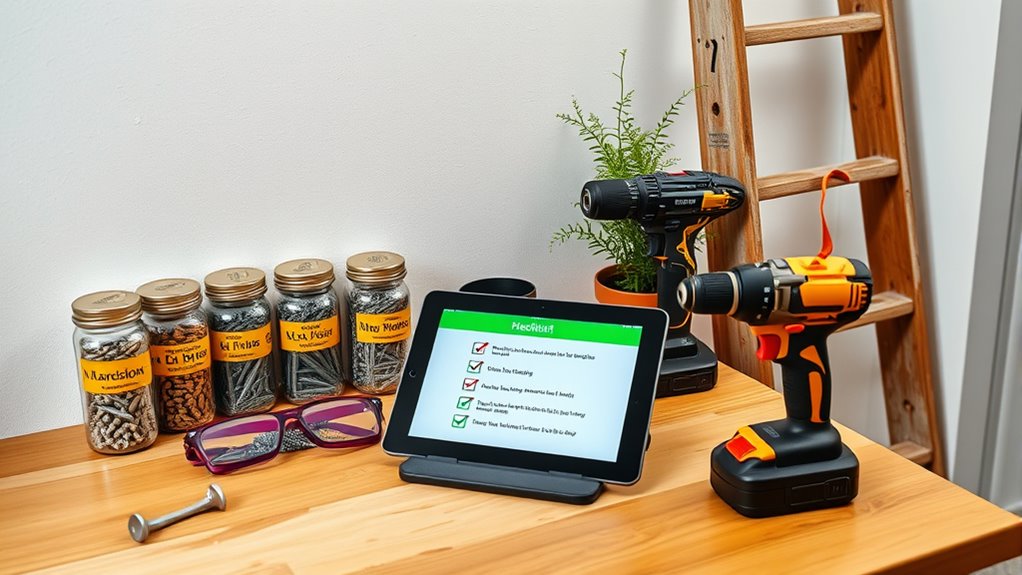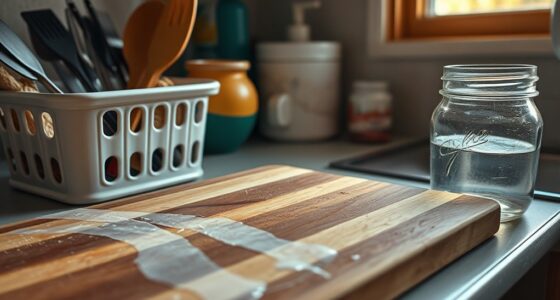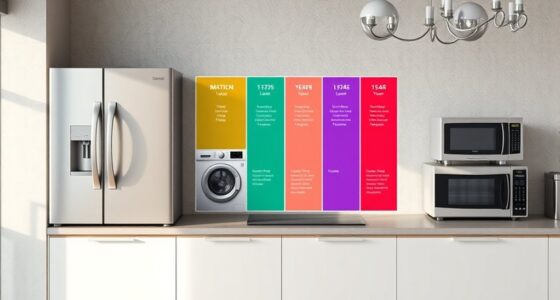To stay ahead with home maintenance, create a checklist that covers monthly tasks like changing HVAC filters and testing smoke detectors, seasonal checks such as sealing drafts and inspecting gutters, and annual deep cleaning and inspections. Don’t forget to review plumbing, electrical systems, and exterior landscaping regularly. Budget wisely for future repairs and upgrades, and keep security systems up to date. Taking these steps now guarantees your home stays safe, efficient, and stress-free—keep going to see how everything fits together.
Key Takeaways
- Implement a monthly routine to check HVAC filters, smoke detectors, and essential home systems for safety and efficiency.
- Conduct seasonal inspections of insulation, weatherproofing, and exterior elements to prepare for upcoming weather changes.
- Schedule annual deep cleaning and structural inspections, including carpets, vents, and potential leaks, for long-term home health.
- Regularly review and update security systems, including surveillance and smart locks, for enhanced safety and peace of mind.
- Maintain a proactive financial plan with dedicated savings for repairs, emergencies, and future home upgrades to ensure longevity and safety.
Monthly Maintenance Tasks
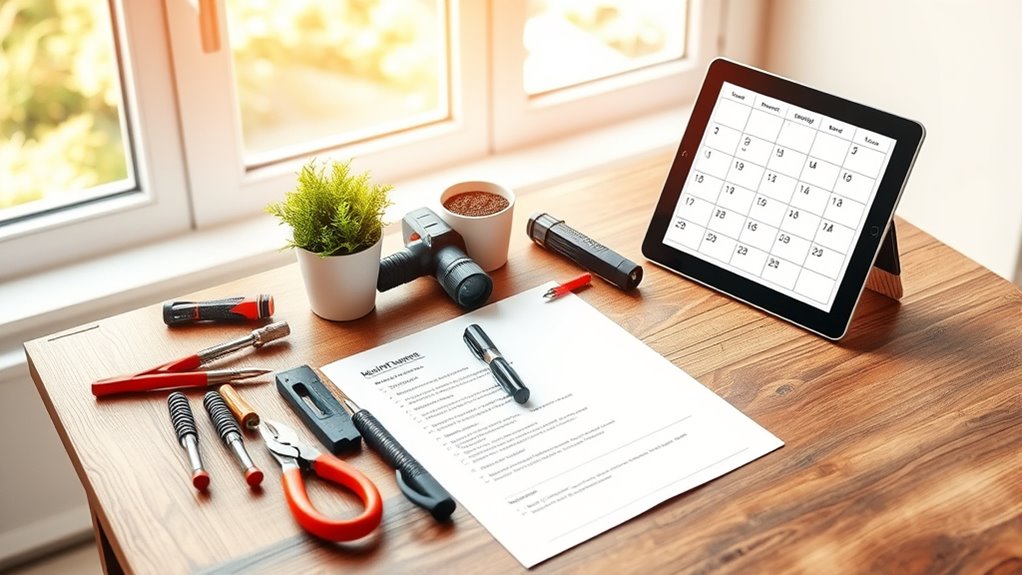
Have you checked your home’s essential systems this month? Regularly inspecting things like your HVAC filter replacement keeps your air clean and system running efficiently. If it’s been over a month, swap out the filter for a fresh one to improve indoor air quality and save energy. Additionally, don’t forget smoke detector testing—press the test button on each device to ensure they’re working properly. Properly functioning smoke alarms are critical for safety, so replace batteries if needed. Staying informed about home maintenance best practices can help you prevent costly repairs and keep your home running smoothly. These simple monthly tasks help prevent breakdowns and ensure your home stays safe and comfortable. Taking just a few minutes for these checks can make a big difference in maintaining a healthy, secure living environment.
Seasonal Home Upkeep Checks

As the seasons change, it is crucial to perform seasonal home upkeep checks to keep your property in top condition. Begin by inspecting your interior decor, ensuring that seasonal accents are stored properly and that humidity levels aren’t causing damage. Check windows and doors for drafts, sealing gaps to improve energy efficiency. In terms of pest prevention, clear away any debris around your home’s exterior and trim back plants that could serve as pest pathways. Also, inspect vents and screens for holes, preventing unwanted invaders. Don’t forget to review your insulation and weatherproofing, adjusting as needed for upcoming weather changes. These checks help protect your home’s structure, interior decor, and pest-free environment throughout the year. Incorporating organic methods into your gardening routine can further enhance your home’s sustainability and health.
Annual Deep Cleaning and Inspection

Performing an annual deep cleaning and inspection is essential for maintaining your home’s safety, efficiency, and appearance. It’s the time to tackle areas that need extra attention, like garage organization and appliance calibration. Deep clean carpets, dust vents, and wipe down surfaces. Inspect your garage for clutter and organize tools and equipment. Check your appliances, ensuring they’re calibrated correctly to save energy and prevent malfunctions. Look over your home’s structural elements for damage or leaks, and replace filters for HVAC systems. Use the table below to guide your inspection: Additionally, understanding brand reputation and authenticity can help ensure you’re using quality products for maintenance tasks.
Plumbing and Electrical System Checks
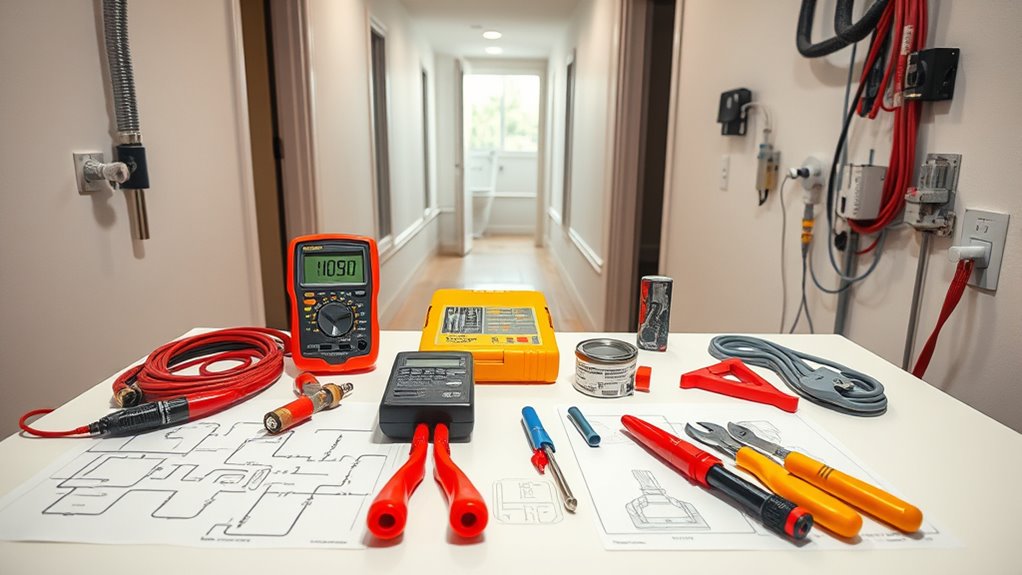
Regularly checking your plumbing and electrical systems helps prevent costly repairs and safety hazards. Start by inspecting your pipes for leaks or drips, and ensure your pipe insulation is intact to prevent freezing during colder months. Replace worn or damaged insulation promptly. For your electrical system, test your circuit breakers regularly to confirm they trip correctly and aren’t worn out. Look for signs of overheating or corrosion around outlets and switches. Keep an eye on any flickering lights or frequent breaker trips, as these indicate potential issues. Address minor problems early to avoid emergencies, and consider scheduling professional inspections periodically. Maintaining your plumbing and electrical systems proactively keeps your home safe, efficient, and saves you money over time. Additionally, incorporating self watering plant pots into your home can reduce the need for frequent watering, helping prevent water-related issues.
Exterior Maintenance and Landscaping

Maintaining the exterior of your home is essential for protecting it from weather damage and enhancing curb appeal. Regular upkeep keeps your property inviting and functional. Focus on tasks like tending to your garden design, cleaning outdoor furniture, and trimming bushes. Check for damaged siding or paint that needs touch-ups, and ensure gutters are clear to prevent water damage. Reseed or mulch your lawn to keep it lush, and prune trees to avoid hazards. Consider revitalizing outdoor furniture to sustain its longevity. Proper landscaping not only boosts aesthetics but also shields your home from the elements. Incorporating electric tools such as battery-powered trimmers and blowers can make these tasks more efficient and eco-friendly.
Safety and Security System Reviews
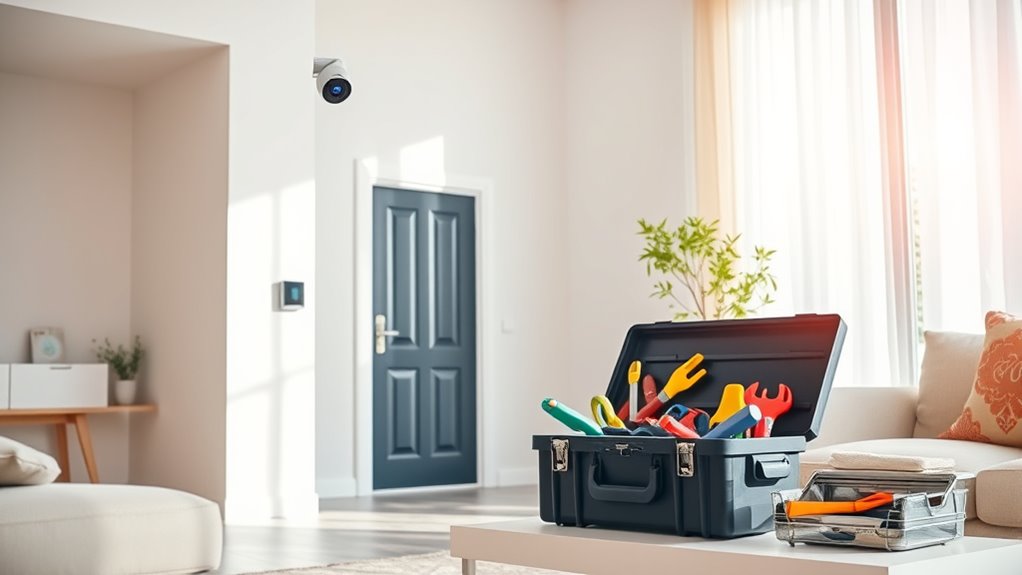
Regularly check your security system to guarantee it’s working properly and providing the protection you need. Keep equipment clean and updated, following the manufacturer’s maintenance tips. Consider upgrading or modernizing your system to improve reliability and integrate new features. Additionally, ensure your system incorporates advanced security features to better defend against emerging threats.
System Effectiveness Checks
To guarantee your safety and security systems function properly, it’s essential to perform regular effectiveness checks. Start by testing alarm sensors and surveillance cameras to ensure they respond promptly. Check smoke and carbon monoxide detectors, replacing batteries if needed. Review your security system’s app or control panel for any alerts or malfunctions. Confirm HVAC efficiency by inspecting thermostats and ensuring proper airflow. Calibrate appliances like smart locks and sensors for peak performance. Additionally, inspect wiring and connections for wear or damage. Conduct routine tests of fire extinguishers and emergency lighting. Keep a log of each check to track system performance over time. Regular reviews help maintain peace of mind, ensuring safety and security systems are always ready when needed. For added assurance, consider security system upgrades to enhance your home’s protection.
Equipment Maintenance Tips
Performing routine reviews of your safety and security equipment is essential to keep them functioning reliably. Start by checking tools calibration to ensure sensors, alarms, and cameras respond accurately. Proper equipment storage is equally important; keep devices in a dry, organized space to prevent damage and make inspections easier. Regularly test alarms, locks, and surveillance systems to confirm they work as intended. Clean sensors and cameras to maintain clear visuals and reliable readings. Replace batteries in wireless devices and update firmware when needed. Keep a maintenance log to track inspections and repairs. Additionally, understanding home safety basics can help prioritize which systems to check first. By staying proactive with these equipment maintenance tips, you reduce the risk of failures during emergencies, maintaining a safer, more secure home environment.
Upgrade and Modernize
Upgrading and modernizing your safety and security systems is essential to keeping your home protected against evolving threats. Modern systems leverage smart technology to provide real-time alerts, remote access, and automation features that enhance security and convenience. When updating, consider:
- Installing smart locks that allow keyless entry
- Adding security cameras with motion detection
- Integrating smart alarms for instant notifications
- Choosing energy-efficient components to reduce power consumption
- Connecting systems to your smartphone for remote monitoring
These upgrades not only improve safety but also boost energy efficiency, saving you money over time. Modern security systems are more intuitive, reliable, and adaptable to your lifestyle, giving you peace of mind knowing your home is protected with the latest technology. Incorporating reliable components can further enhance the overall performance and durability of your security setup.
Budgeting for Future Repairs

Planning for future repairs is essential to keep your home in good condition without unexpected expenses derail your budget. Start by implementing cost saving strategies, such as shopping around for affordable repairs and scheduling maintenance during off-peak times. Regularly setting aside money for an emergency fund ensures you’re prepared for costly surprises like plumbing failures or roof leaks. Create a dedicated savings account and contribute consistently, even if it’s a small amount. By proactively budgeting, you’ll avoid debt and reduce stress when repairs arise. Keep track of maintenance costs and adjust your savings plan accordingly. Staying informed about best laundry detergents can help you choose cost-effective cleaning solutions that last longer, ultimately saving you money. This approach not only helps you manage expenses but also prolongs your home’s lifespan, giving you peace of mind knowing you’re financially ready for whatever comes next.
Frequently Asked Questions
How Do I Prioritize Home Repairs With a Limited Budget?
When prioritizing home repairs on a limited budget, focus on safety and essential functions first. Use cost-effective upgrades to fix urgent issues, like leaks or electrical problems. Employ prioritization strategies by listing repairs from most to least critical, then plan your spending accordingly. This way, you address immediate needs without overspending, ensuring your home remains safe and functional while gradually improving it over time.
What Are Signs of Hidden Water Leaks in My Home?
You might notice signs of hidden water leaks if you see basement moisture or unexplained damp spots. Keep an eye on your walls and floors for discoloration or mold growth. Listen for the sound of dripping or running water when no fixtures are in use. Pipe corrosion can also indicate leaks; rusty or corroded pipes often leak silently. Regular inspections help catch these issues early before they cause costly damage.
How Often Should I Replace HVAC Filters for Optimal Efficiency?
Oh, sure, you could just ignore HVAC maintenance and hope your filters last forever, but let’s be real. For peak efficiency, you should replace your filters every 1 to 3 months, depending on usage and filter lifespan. Neglecting this simple task can turn your HVAC system into a sluggish, dust-bunny factory. Stay proactive—change those filters regularly to keep your home fresh, healthy, and running smoothly.
What’S the Best Way to Prevent Pest Infestations Year-Round?
To prevent pest infestations year-round, you should focus on effective pest prevention and pest proofing strategies. Regularly seal cracks and gaps around doors, windows, and the foundation to keep pests out. Keep your home clean and dry, especially in food storage areas. Trim vegetation away from the house, and store firewood off the ground. These proactive steps help create an environment that’s less attractive to pests, reducing the chance of infestations.
How Can I Improve Home Energy Efficiency Beyond Maintenance?
Imagine your home as a fortress, constantly battling energy waste. To go beyond basic maintenance, consider solar upgrades that harness the sun’s power, reducing your bills and environmental impact. Pair this with smart thermostats that learn your schedule, optimizing comfort and efficiency effortlessly. These upgrades create a smarter, greener home, saving you money while giving you peace of mind, knowing you’re doing everything possible to boost your energy efficiency.
Conclusion
So, while this checklist might seem like a lot, neglecting it could cost you way more in the long run. Ironically, staying on top of routine maintenance keeps unexpected disasters at bay—yet many still wait until something breaks. Don’t wait until a small issue becomes a costly surprise. Stay proactive, enjoy peace of mind, and maybe, just maybe, you’ll thank yourself later for doing what you wish you’d started sooner.
